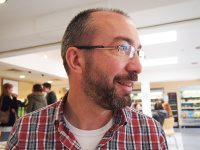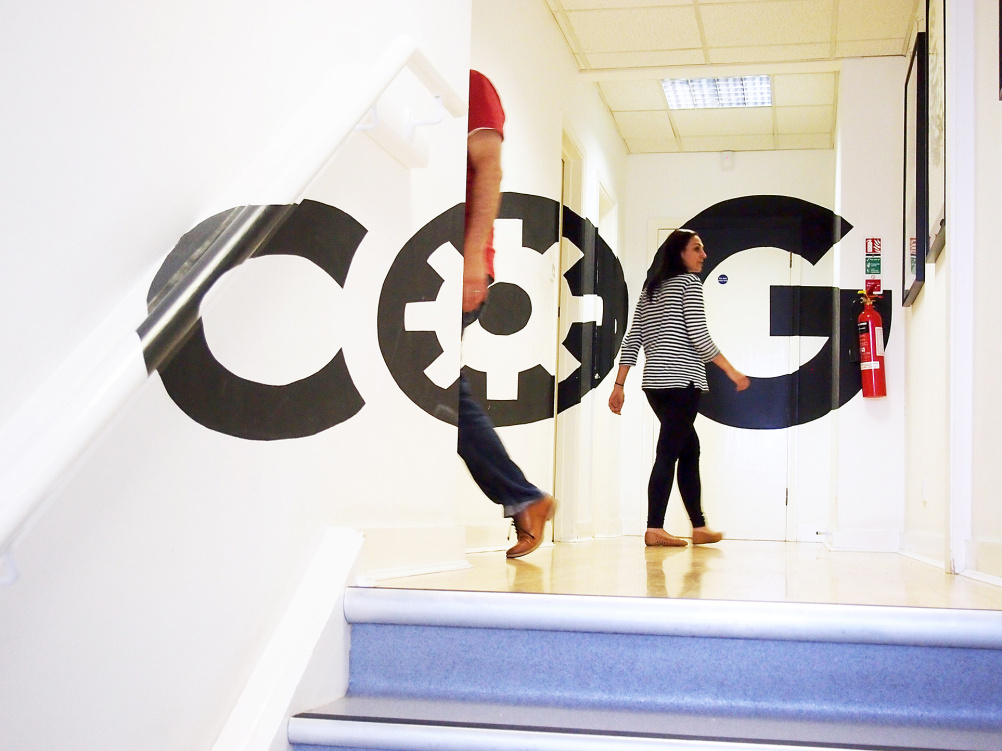Ten Questions for: Michael Smith
Michael Smith founded Cog Design in 1991, designing club flyers and band T-shirts. He talks to us about being brave, not being precious and learning to ‘say no’.

When did you realise you wanted to be a designer?
It was never a conscious plan (and I still might change my mind) but I suppose I drifted into it from my late teens. Lots of different streams of influence combined and steered me in this direction. The political posters, record sleeves, badges and T-shirts of my teenage years were probably the first big influence. I lost interest in school before I got to A-Levels so I decided to go to art college, it looked like more fun than academic study. I was lucky that graphic design was a relatively new career option so there were lots of new courses on offer (and tuition fees were paid for). Whilst I was at college I realised that if you design band T-shirts you get into gigs for free, and if you design club flyers then you get a tab at the bar; those were my keenest interests at the time so that’s what I did.
What was your first job?
I’ve never had a proper job although I did lots of awful part-time and holiday jobs when I was in education. When I left art college I spent a few months enjoying myself and then signed-on. After six months I had to go for a restart interview and they offered me two choices: either take the next job on offer or start my own business under the ‘Enterprise Allowance Scheme’ (EAS). That was a no-brainer, EAS offered £42 a week for a year, while I’d been living on the £27.30 dole-money. I started trading under the name Cog Design on 4 May 1991, designing club flyers and band T-shirts (as I always had done) and that has somehow spiraled into the company that I still run today.
How would you describe what you currently do?
I see myself as a design producer (like a film or theatre producer). I gather the right talent together, establish the relationships, set the expectations, negotiate the figures and provide the environment and circumstances for everyone to do their best work; then I try to leave the designers with the space to be brilliant, providing support, encouragement and experienced constructive criticism along the way. That’s how I’d describe it, I’m sure others will have their own perspectives.
What has been the biggest change in design since you started?
When I started I worked on a drawing board. When I did buy my first computer (an Apple LCIIsi) it was only used to produce elements of designs that were then pasted together. We had a 5pm deadline when a courier would pick up floppy disks to take to an overnight bureau. They’d run out the artwork elements and deliver them back at 8am, then we had the day to paste-up the artwork and mark it up for the printers’ all-night repro-houses. I’m pleased we don’t have to work like that any more but it did have lots of positives; the process made us all very disciplined, we had to really understand the medium we were working in and we had to learn to embrace mistakes because there was no time to correct them.

What is your favourite project, that you’ve worked on?
That’s such a difficult question. I’ve been lucky enough to be part of some amazing projects with incredible clients. But design is all about context; I get very tired of the way designers praise (or dismiss) each other’s work without understanding the timings of the project, the budget, the politics, the client, the team and every other contributory factor. My favourite projects are always when our clients are delighted with the results, when it feels like we found the perfect answer to a difficult puzzle.
What is your favourite project, that you haven’t worked on?
A few years ago, Multistorey did the rebranding for Lyric Theatre, Hammersmith. At the time, it was such a fresh piece of thinking that it completely changed my perspective about how design can be used in venue branding. I don’t know the people involved but it must have taken a really brave and determined team (designers, clients and everyone else) to make it happen. It made me determined to be braver and to push our work into venue branding which we’ve done a lot of since then.
What was your biggest mistake?
I make mistakes every day; I wish I was better at learning from them. My biggest mistake is probably that I’m not brave enough. Where other designers say ‘no’ to clients, I’ll always try to find a pragmatic solution; that can mean a compromise that neither of us are entirely comfortable with. I am slowly learning that saying ‘no’ can help the client and the project.
What is your greatest ambition?
Short-term, I want to steer Cog to its 25th anniversary. I know it’s an arbitrary date but it feels pretty special that we’re only two years away from a quarter of a century. Longer term, I’d love to play a role in communication design being taken more seriously as a profession, with accreditation and some objective measures of who are ‘good’ designers.
Who is the most inspirational person you have worked with?
I’m lucky enough to cross paths with brilliant people all of the time. Our clients include some hugely talented individuals. I try to learn from everyone I meet. It’s inspiring to see artistic directors with original vision and the charisma to make things happen; for me, it’s equally exciting to work with the teams who deliver that vision and take care of every detail. I’ve also worked with incredible colleagues at Cog. Many have gone on to start their own agencies, carve unique careers across the globe, or have shifted direction to start a family or pursue other dreams. I’ve learned lessons from each of them.
What piece of advice would you give to people starting out in design?
Don’t wait for others to teach you stuff, go out and grab the knowledge and experience for yourself. Don’t let your self-consciousness get in the way of your enthusiasm; people love working alongside enthusiastic colleagues. Be generous with your time, open to new ideas and alive to possibilities because you never know when and where opportunities will come from. Be determined and focused but don’t be demonstrative or precious.
Michael Smith is the founder of Cog Design, cogdesign.com. Find him on Twitter at @cog_design
-
Post a comment




